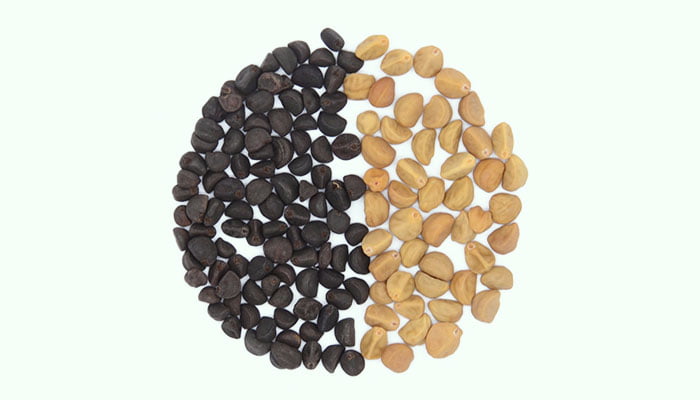What Is Qian Niu Zi
Qian Niu Zi also known as Semen Pharbitidis or Morning Glory Seed is the seed of Pharbitis nil or Pharbitis purpurea, which is an annual twining herb belonging to the family Convolvulaceae. It is a commonly used Chinese herbal medicine, which first appeared in <Mingyi Bie Lu> around 420-589 AD.
Pharbitis nil is commonly known as Ipomoea nil, picotee morning glory, ivy morning glory, or Japanese morning glory and is a common ornamental plant.
This plant likes light and is not hardy. It often grows on hillsides, thickets, riversides, or roadsides 100-1,600 meters above sea level. It is native to Central America and Mexico and has now been widely introduced.

Pharbitis purpurea is commonly known as Ipomoea purpurea, the common morning-glory, tall morning-glory, or purple morning glory.
This plant likes a warm and humid environment. It often grows on fields, roadsides, houses, or hillsides below 2,800 meters above sea level. It is native to tropical America and is now widely introduced throughout the world.
In the late autumn of each year, people pick the mature fruits of Pharbitis nil or Pharbitis purpurea, take out their seeds, remove their impurities, dry them in the sun, use them directly or stir-fry them, and make them into Chinese herbal medicines.
Qian Niu Zi contains pharbitin, isopenniclavine, chanoclavine, ergometrine, ergosine, ergosinine, lyser-gol, agroclavine, elymoclavine, penniclavine, cinnamic acid, ferulic acid, chlorogenic acid, rhein, 12-hydroxy-methylabietate, 12-hydroxy-hydromethylabi etate, physcion, emodin, chrysophanol, caffeic acid ethyl ester, caffeic acid methyl ester, caffeic acid, β-sitosterol, 12-hydroxyabietic acid, rhamnose, fructose, glucose, sucrose, gibberellin A5, gibberellin A3, and gibberellin A20.
In general, the black-brown or yellow-brown Qian Niu Zi with a slight fragrance is preferred.
According to <Compendium of Materia Medica>, the medicinal nature of Qian Niu Zi is relatively cold, with toxicity and a bitter taste. It has a certain therapeutic effect on the pathological changes of the lung, kidney, and large intestine meridians.
In traditional Chinese medicine, Qian Niu Zi is used to remove water retention and kill insects, treat asthma, bronchitis, pediatric pneumonia, migraine, tuberculous pleurisy, infantile malnutrition, intractable constipation, enteric neurosis, anal fissure, hemorrhoids, proctitis, gastritis, cirrhotic ascites, enterobiasis, nephritis, hydrocele of tunica vaginalis, prostatic hyperplasia, epilepsy, leukorrheal diseases, and allergic purpura.
There are about 50 kinds of Chinese medicine prescriptions containing it, such as Kaixiong Shunqi Wan, Mu Xiang Bing Lang Wan, and Niuhuang Qingwei Wan.
Benefits
- Increasing spleen index, enhancing splenic lymphocyte function, and improving immunity.
- Exciting the smooth muscle of the uterus and increasing the amplitude of uterine contraction.
- Anti-inflammation, inhibiting xylene-induced ear swelling in mice and carrageenan-induced foot swelling in mice.
- Inducing diuresis and treating dysuria, constipation, edema, and tympanites.
- Purging lung qi and eliminating phlegm, treating edema of the face and eyes, and cough caused by retention of phlegm and morbid fluid.
- Killing roundworms and tapeworms, relieving abdominal pain caused by a parasitic infestation.
- Inhibiting the growth of liver cancer cell BEL-7402, colon cancer cell HCT-8, and lung cancer cell A-549.
- Studies have confirmed that the combination of pharbitin with bile and intestinal juice in the intestinal lumen can stimulate the intestine, improve intestinal peristalsis, and induce defecation.
Combinations
- It can be used in combination with Da Huang (Radix et Rhizoma Rhei), Bing Lang (Semen Arecae), etc. to treat pneumonia in children.
- It can be used in combination with Hua Shi (Talcum), Huang Qin (Radix Scutellariae), Da Huang (Radix et Rhizoma Rhei), etc. to treat leukorrheal diseases caused by damp-heat.
- It can be used in combination with Da Huang (Radix et Rhizoma Rhei), Xing Ren (Semen Armeniacae), Ting Li Zi (Semen Lepidii), Huang Qi (Radix Astragali), Dang Shen (Radix Codonopsis), etc. to treat acute nephritis.
- It can be used in combination with Shi Chang Pu (Rhizoma Acori Tatarinowii), Ku Fan (Dried Alum), Long Gu (Fossilia Ossis Mastodi), Di Long (Earthworm), etc. to treat primary epilepsy.
- It can be used in combination with Jue Ming Zi (Cassia Seed), Ze Xie (Rhizoma Alismatis), He Ye (Folium Nelumbinis), Shan Zha (Hawthorn Fruit), Bai Zhu (Rhizoma Atractylodis Macrocephalae), Dan Shen (Radix et Rhizoma Salviae Miltiorrhizae), Da Fu Pi (Pericarpium Arecae), etc. to treat simple obesity.
Side Effects
- Qian Niu Zi is poisonous and its toxic component is glycosides. The toxicity mainly affects the nervous system, digestive system, and urinary system.
- Overdose of it may cause vomiting, abdominal pain, diarrhea, mucous bloody stools, or hematuria. In severe cases, it can damage the nervous system and cause speech disorders or coma.
Precautions and Warnings
- The dosage of Qian Niu Zi should be controlled at 3-9g.
- It can be made into decoctions, pills, or powder.
- Stir-frying it can slow down its efficacy.
- It should not be taken with a drug containing Ba Dou (Croton Seed).
- Patients with a weak stomach or qi deficiency should not take it.
- Pregnant women, breastfeeding women, and children should not take it.
